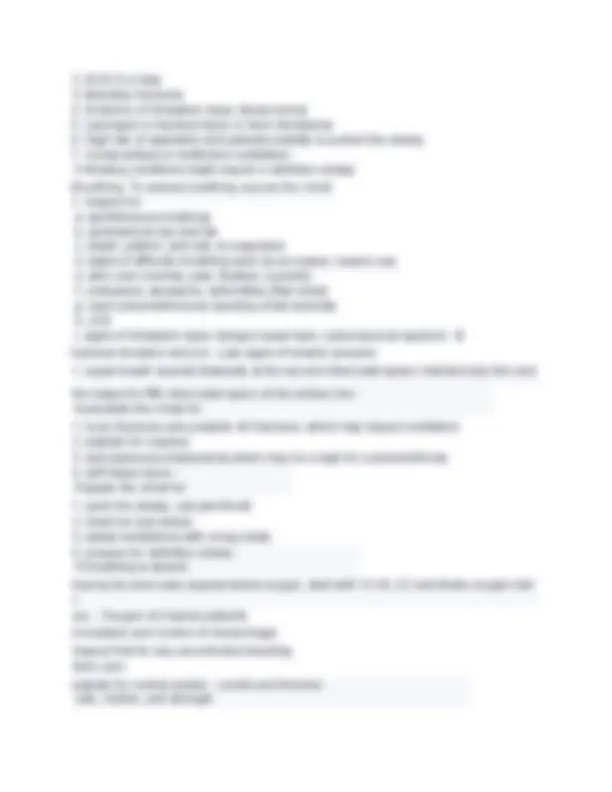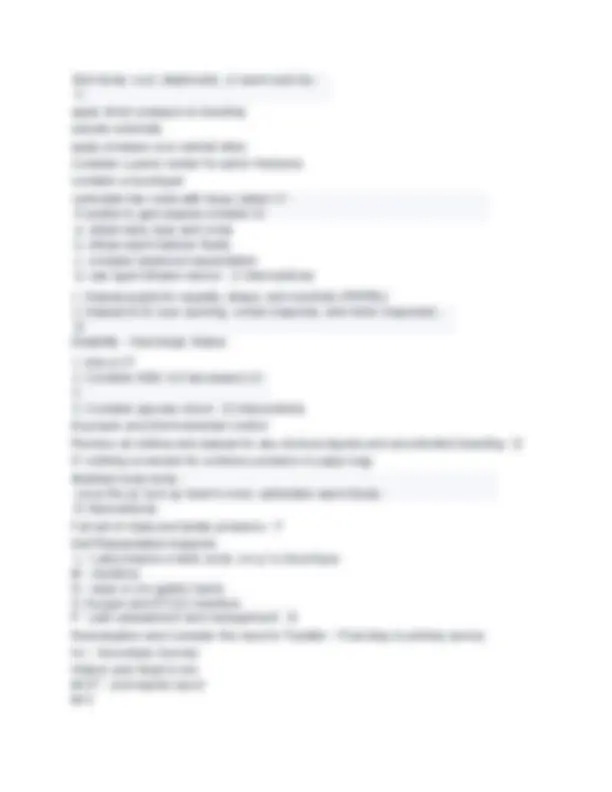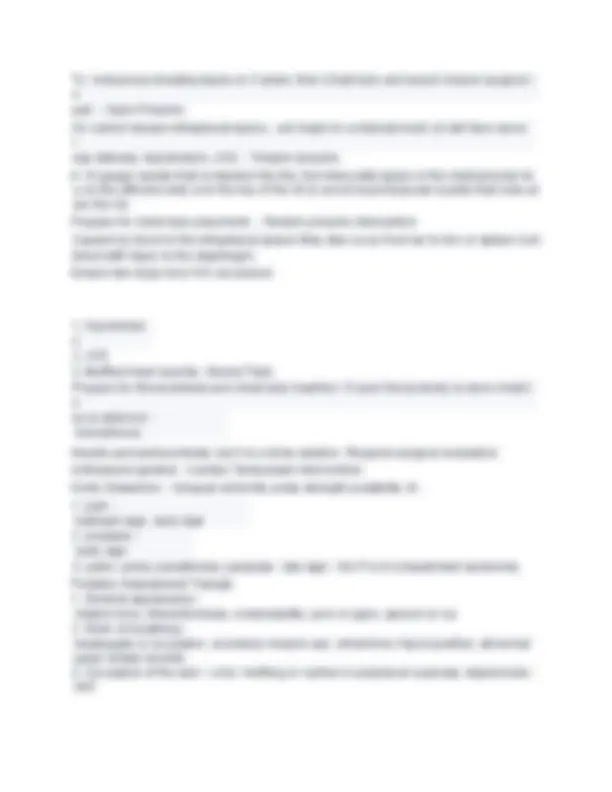







Study with the several resources on Docsity

Earn points by helping other students or get them with a premium plan


Prepare for your exams
Study with the several resources on Docsity

Earn points to download
Earn points by helping other students or get them with a premium plan
Community
Ask the community for help and clear up your study doubts
Discover the best universities in your country according to Docsity users
Free resources
Download our free guides on studying techniques, anxiety management strategies, and thesis advice from Docsity tutors
A set of questions and answers related to the tncc (trauma nursing core course) exam. It covers various aspects of trauma care, including airway management, breathing assessment, circulation control, and neurologic status. Useful for students preparing for the tncc exam, but it lacks detailed explanations and may not be sufficient for a comprehensive understanding of the subject.
Typology: Exams
1 / 9

This page cannot be seen from the preview
Don't miss anything!






I!l I!l
Skin 6 temp: 6 cool, 6 diaphoretic, 6 or 6 warm 6 and 6 dry 6 - 6 C I!l I!l apply I!l 6 direct 6 pressure 6 to 6 bleeding I!l elevate 6 extremity I!l I!l apply 6 pressure 6 over 6 arterial 6 sites I!l I!l Consider I!l 6 a 6 pelvic 6 binder 6 for 6 pelvic 6 fractures I!l consider 6 a 6 tourniquet I!l I!l cannulate 6 two 6 veins 6 with 6 large 6 caliber 6 IV 6 - 6 if 6 unable 6 to 6 gain 6 assess 6 consider 6 IO 6 6 a. 6 obtain 6 labs, 6 type 6 and 6 cross I!lI!l 6 b. 6 infuse 6 warm 6 isotonic 6 fluids 6 c. 6 consider 6 balanced 6 resuscitation 6 I!l 6 d. 6 use 6 rapid 6 infusion 6 device 6 - 6 C 6 Interventions: I!l I!l Disability I!l 6 - 6 Neurologic 6 Status 6 I!l I!l
Injuries 6 sustained I!l SI!l 6 s/s 6 in 6 the 6 field I!lT 6 treatment 6 in 6 the 6 field if 6 patients 6 family 6 present 6 get 6 a 6 better 6 hx 6 on 6 them 6 - 6 H I!l I!l Sample 6 is 6 part 6 of 6 history I!l S 6 symptoms 6 associated 6 with 6 injury I!l A 6 allergies 6 and 6 tetanus 6 status I!l M 6 meds 6 currently 6 on 6 including 6 anticoagulant 6 therapy I!l P 6 past 6 medical 6 hx I!l L 6 last 6 oral 6 intake I!l E I!l 6 Events 6 and 6 environment 6 factors 6 related 6 to 6 the 6 injury 6 - 6 SAMPLE I!l inspect I!l 6 for 6 lacs, 6 abrasions, 6 asymmetry 6 of 6 facial 6 expressions I!l palate 6 for 6 depressions 6 and 6 tenderness I!l I!l look I!l 6 at 6 ears 6 for 6 drainage 6 - 6 Head 6 to 6 toe 6 assessment: 6 Head 6 and 6 face I!l immobilize 6 cervical 6 spine, 6 tenderness, 6 tracheal 6 deviation 6 - 6 Head 6 to 6 toe 6 assessment: 6 Neck 6 and 6 cervical 6 spine I!l I!l inspect, I!l 6 auscultate, 6 palpate I!l any I!l 6 spontaneous 6 breathing, 6 rate, 6 depth, 6 and 6 degree 6 of 6 effort, 6 use 6 of 6 accessory 6 muscles 6 I!l lacs, I!l 6 contusions, 6 I!l auscilate 6 lung 6 sounds 6 and 6 heart 6 sounds 6 - 6 Head 6 to 6 toe 6 assessment: 6 Chest I!l I!l don't 6 forget 6 flanks!!! I!l I!l inspect I!l 6 of 6 lacs, 6 puncture 6 wounds, 6 contusions, 6 I!l auscultate 6 then 6 palpate: 6 I!l I!l bowel 6 sounds? 6 I!l I!l any 6 rigidity, 6 guarding? 6 begin 6 with 6 light 6 palpation 6 start 6 to 6 palpate 6 with 6 side 6 that 6 does 6 not 6 h urt 6 I!l I!l maybe I!l 6 do 6 a 6 fast 6 scan? 6 - 6 Head 6 to 6 toe 6 assessment: 6 Abdomen I!l any 6 lacs? 6 deformities? 6 blood 6 at 6 the 6 urtheral 6 meatus I!l I!l palpate 6 pelvis 6 with 6 high 6 pressure 6 over 6 the 6 iliac 6 wings 6 downward 6 and 6 medially 6 - 6 Head 6 to 6 toe 6 assessment: 6 pelvis 6 and 6 perineum I!l I!l any 6 deformities? 6 bleeding? 6 contusions, 6 lacs? 6 skin 6 temp?? 6 place 6 splints 6 on 6 deformities, 6 pulses 6 - 6 Head 6 to 6 toe 6 assessment: 6 Extremities I!l I!l inspect 6 posterior 6 surfaces 6 I!l I!l blogroll I!l 6 with 6 at 6 least 636 people. 6 maintain 6 c 6 spine I!l take 6 out 6 backboard 6 I!l I!l I!l Rectal I!l 6 tone 6 per 6 MD 6 - 6 I I!l labs, 6 wound 6 care, 6 tetanus, 6 administer 6 meds, 6 prepare 6 for 6 transfer 6 - 6 Secondary 6 Reval 6 Adjuncts I!l I!l
. I!l 6 I!l Goal: 6 Volume 6 replacement 6 and 6 vasoconstriction 6 - 6 Distributive 6 Shock I!l I!l A I!l 6 breath 6 every 656 to 666 seconds: 610 - 126 ventilations 6 per 6 minute 6 - 6 Bag 6 mask 6 ventilation I!l Stroke 6 Volume 6 X 6 HR 6 - 6 Cardiac 6 Output 6 = I!l I!l t 6 I!l activation: 6 consist 6 of 6 carotid 6 and 6 aortic 6 bodies. 6 ... 6 detect 6 changes 6 in 6 blood 6 oxygen 6 and 6 C I!lo2 6 and 6 pH. 6 When 6 Co2 6 rises 6 or 6 oxygen 6 level 6 of 6 pH 6 falls 6 these 6 receptors 6 are 6 activated 6 an I!ld 6 information 6 is 6 relayed 6 to 6 the 6 CNS 6 and 6 the 6 cardiorespiratory 6 centers 6 in 6 the 6 medulla 6 , 6 w I!lhich 6 increases 6 respiratory 6 rage 6 and 6 depth 6 and 6 BP 6 - 6 Chemoreceptors: I!l I!l 506 to 61506 - 6 MAP 6 Range I!l I!l the 6 decrease 6 coagulopathy 6 .. 6 you 6 will 6 you 6 bleed 6 more 6 - 6 The 6 colder 6 you 6 are 6 the 6 more 6 acidic 6 you 6 are.. I!l I!l in 6 massive 6 transfusion 6 protocol... 6 responsible 6 for 6 dissolving 6 clots 6 - 6 TXA I!l I!l stabilized 6 vital 6 signs, 6 improved 6 mental 6 status, 6 improved 6 urine 6 output 6 - 6 What 6 are 6 indicators 6 of 6 increased 6 perfusion? I!l I!l 6 - 6 Prehospital 6 shock 6 index 6 pg. 685 I!l I!l Flail 6 chest 6 - 6 Paradoxical 6 chest 6 wall 6 movement I!l I!l can 6 be 6 caused 6 by 6 blunt 6 trauma. 6 air 6 escapes 6 from 6 injured 6 lung 6 to 6 pleural 6 space 6 and 6 nega tive 6 intrapleural 6 pressure 6 is 6 lost 6 causing 6 partial 6 or 6 collapsed 6 lung 6 - 6 Simple 6 Pneumothorax I!l I!l
Tx: 6 nonporous 6 dressing 6 tapes 6 on 636 sided, 6 then 6 Chest 6 tube 6 and 6 would 6 closure 6 surgical 6 r e pair. 6 - 6 Open 6 Pneumo: I!l I!l Air 6 cannot 6 escape 6 intrapleural 6 space.. 6 can 6 begin 6 to 6 compress 6 heart. 6 pt 6 will 6 have 6 sever 6 r esp 6 distress, 6 hypotension, 6 JVD. 6 - 6 Tension 6 pneumo I!l I!l A 6146 gauge 6 needle 6 that 6 is 6 inserted 6 into 6 the 6 2nd 6 intercostal 6 space 6 in 6 the 6 midclavicular 6 lin I!le 6 on 6 the 6 affected 6 side 6 over 6 the 6 top 6 of 6 the 6 rib 6 to 6 avoid 6 neuromuscular 6 bundle 6 that 6 runs 6 un I!lder I!l 6 the 6 rib. 6 I!l Prepare 6 for 6 chest 6 tube 6 placement. 6 - 6 Tension 6 pneumo 6 intervention I!l I!l Caused 6 by 6 blood 6 in 6 the 6 intrapleural 6 space/ 6 May 6 also 6 occur 6 from 6 lac 6 to 6 live 6 or 6 spleen 6 com bined 6 with 6 injury 6 to 6 the 6 diaphragm. 6 I!l I!l Ensure 6 two 6 large 6 bore 6 IVS 6 are 6 placed. 6 I!l I!l Prepare 6 for 6 thoracentesis 6 and 6 chest 6 tube 6 insertion. 6 If 6 open 6 thoracotomy 6 is 6 done 6 chest 6 t u be 6 is 6 deferred. 6 - 6 Hemothorax: I!l I!l I!l Needle I!l 6 pericardiocentesis, 6 but 6 it 6 is 6 a 6 temp 6 solution. 6 Requires 6 surgical 6 evaluation. I!l (Ultrasound 6 guided) 6 - 6 Cardiac 6 Tamponade 6 Intervention: I!l I!l Aortic I!l 6 Dissection 6 - 6 Unequal 6 extremity 6 pulse 6 strength 6 possibility 6 of.. I!l